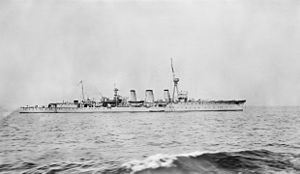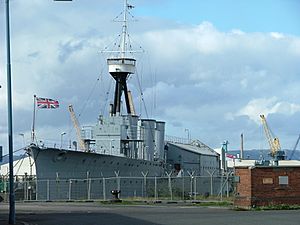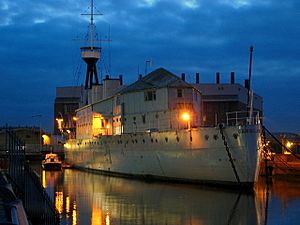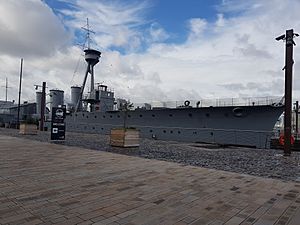HMS Caroline (1914) facts for kids

HMS Caroline in 1917
|
|
Quick facts for kids History |
|
|---|---|
| Name | HMS Caroline |
| Builder | Cammell Laird |
| Laid down | 28 January 1914 |
| Launched | 29 September 1914 |
| Completed | December 1914 |
| Commissioned | 4 December 1914 |
| Decommissioned | February 1922 |
| Recommissioned | February 1924 |
| Decommissioned | 31 March 2011 |
| Motto | Tenax Propositi ("Tenacious of Purpose") |
| Honours and awards |
Battle honour for Jutland 1916 |
| Status | "Museum Ship" in Belfast, Northern Ireland |
| General characteristics | |
| Class and type | C-class light cruiser |
| Displacement |
|
| Length | 420 ft (128.0 m) (446 ft (135.9 m) overall) |
| Beam | 41.5 ft (12.6 m) |
| Draught | 16 ft (5 m) maximum |
| Propulsion |
|
| Speed | 28.5 knots (53 km/h) |
| Range | carried 405 tons (772 tons maximum) of fuel oil |
| Complement | 325 |
| Armament |
|
| Armour |
|
HMS Caroline is a famous light cruiser ship from the Royal Navy. She fought in the First World War and was used as a main office during the Second World War.
Caroline was built and started service in 1914. When she stopped being used in 2011, she was the second-oldest ship still active in the Royal Navy. Only HMS Victory was older. For many years, she was a training ship for the Royal Naval Reserve in Belfast, Northern Ireland. Today, she is a museum ship that you can visit.
Caroline is special because she is the last British light cruiser from the First World War that is still floating. She is also the only ship left that fought in the famous Battle of Jutland.
Contents
Building the Ship
HMS Caroline was built by a company called Cammell Laird in Birkenhead, England. Her construction started on 28 January 1914. She was launched into the water on 29 September 1914 and was finished in December 1914.
Caroline was one of the first C-class light cruisers. Her engines are still inside the ship today, even though they don't work anymore.
Ship's History
First World War Service
Caroline officially started her service on 4 December 1914. She spent the entire First World War in the North Sea. When she first joined the fleet, she was part of the Grand Fleet based at Scapa Flow in the Orkney Islands.
From 1916 until the end of the war in November 1918, she was part of the 4th Light Cruiser Squadron. She fought in the big Battle of Jutland on 31 May – 1 June 1916. From 1917, she even carried a special platform to launch planes. These planes would fly off to stop German airships over the North Sea.
Between the World Wars
After the First World War, Caroline continued to serve. In June 1919, she went to the East Indies Station, which was a naval base far away. In February 1922, she was put into "reserve," meaning she was kept ready but not actively used.
In February 1924, she was brought back into service. She became a main office and training ship for the Royal Naval Volunteer Reserve in Belfast, Northern Ireland. Her guns and some parts of her engines were removed around 1924. These guns were then used to make the coastal defenses stronger in other ports.
Second World War Service
From 1939 to 1945, during the Second World War, Caroline was the Royal Navy's main office in Belfast Harbour. This harbor was a very important base for many warships. These ships helped protect convoys of other ships crossing the Atlantic Ocean and going to the Arctic.
As Belfast became a big naval base, the main office grew too large for Caroline alone. So, other buildings in the city were also used as part of HMS Caroline. For example, Belfast Castle was used and had a radio station. Many sailors wore Caroline cap tallies, even if they weren't on the ship itself.
After the Wars
After the Second World War, the Royal Navy gave Caroline back to the Royal Naval Volunteer Reserve. She continued to be their last floating training base. She was repaired in Belfast in 1951.
The Royal Naval Reserve Unit moved off the ship in December 2009. Caroline herself stopped being an active ship on 31 March 2011. This was done in a special ceremony. Her flag was placed in St Anne's Cathedral in Belfast.
Becoming a Museum

Caroline is now part of the National Historic Fleet, which means she is a very important ship in British history. After she stopped active service, she was looked after by the National Museum of the Royal Navy. She stayed in her spot in Alexandra Dock in Belfast.
Even though she can't move on her own, Caroline is still floating and in great condition. Sometimes, strong waves and winds have made her almost break free from her ropes. In 2005, during a storm, she pulled out some huge metal posts from the dock! She wasn't usually open to visitors, except during the yearly RMS Titanic celebrations.
When Caroline stopped being used in 2011, people weren't sure what would happen to her. There were ideas to make her look exactly like she did in the First World War. This would mean finding and putting back her old guns. One idea was for her to stay in Belfast as a museum ship in the Titanic Quarter. Another idea was to move her to Portsmouth.
In June 2012, plans were announced to move Caroline to Portsmouth, if enough money could be found. However, in October 2012, the Northern Ireland government said she would stay in Belfast. They also announced that a special fund would give £1,000,000 to help restore her. In May 2013, another fund gave £845,600 to help turn her into a museum.
In October 2014, the Heritage Lottery Fund gave a big boost of £12 million. This money helped the National Museum of the Royal Navy get Caroline ready as a visitor attraction. They wanted her to be open in time for the 100-year anniversary of the 1916 Battle of Jutland.
Caroline is still in the Alexandra Dock in the Titanic Quarter in Belfast.
In June 2016, HMS Caroline officially opened to the public as a museum ship. She is now part of the National Museum of the Royal Navy.
Important Records
When she stopped active service in 2011, Caroline was the second-oldest ship still in the Royal Navy. Only HMS Victory was older. She is also the last British light cruiser from the First World War that was still active. Most importantly, she is the last ship still afloat that fought in the famous Battle of Jutland.
Images for kids
See also
 In Spanish: HMS Caroline (1914) para niños
In Spanish: HMS Caroline (1914) para niños





